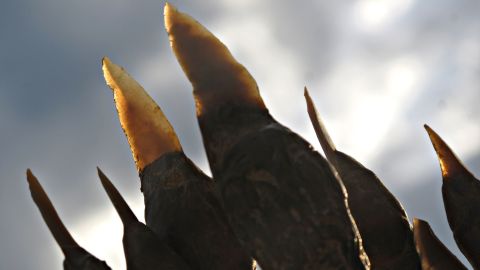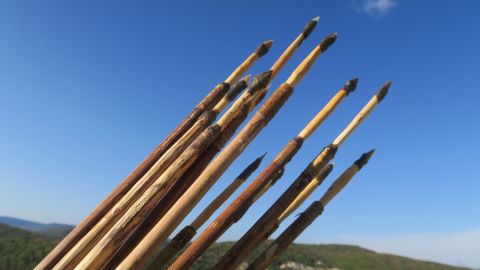Archaeologists digging in a cave in southern France say they have unearthed the earliest evidence of bow and arrow use outside Africa.
Grotte Mandrin, near Malataverne in the Rhône Valley, is a cave that was inhabited by early modern humans about 54,000 years ago. A research team recovered more than 300 tiny arrowheads intricately crafted in a style known as Neronian at the ancient site. Scientists believe the cave’s inhabitants are the earliest Homo sapiens to have arrived in a region that had long been home to another group of hominins, the Neanderthals.
Almost 200 of the surprisingly delicate arrowheads showed patterns of impact and damage that suggested they had once been thrust, thrown or mechanically propelled in some way, according to the research published Wednesday in the journal Science Advances.
It’s possible, the researchers said, that possessing advanced projectile weaponry, such as a bow and arrow, could have given these early Europeans an advantage over Neanderthals, who disappeared about 40,000 years ago.
The arrowheads found in the cave were of different sizes. The largest artifacts were 60 millimeters (2.4 inches) in length, while the smallest were just 10 millimeters (0.4 inch). To understand exactly how the points were used, co-lead study author Laure Metz, an archaeologist at Aix-Marseille Université in France, and her colleagues undertook a series of experiments with replica weapons.
Early humans used a ballistic technology
The study team made 82 replica flint points and attached them to shafts of wood using natural glue made from tree sap, beeswax and the mineral ocher, the residues of which had been found on some of the flint tips. In total, the researchers made 82 projectiles.
Metz worked with a skilled archer, who fired the arrows and spears at a goat carcass — nine were tested by hand and 73 with a spear thrower and a bow made with a deer tendon. The team found that the small size and weight of the flint points meant the points worked best when fired with a bow.

Arrows shot from a bow penetrated much deeper — more than 25 centimeters (9.8 inches) deeper — than the points launched with a spear thrower, with 10 of the arrows passing all the way through the goat carcass, according to the study. Hand-thrown spears rarely penetrated the animal’s skin, the researchers wrote.
Fracture marks on the replica flints shot with a bow also closely matched the pattern of wear on many of the points excavated from the cave, revealing them to be the result of a “ballistic technology,” such as a bow and arrow, the study said.
“When you have these light weapons you need to correct this low kinetic energy with mechanical propulsion. And the only way to make these fractures on the really tiny arrows … was with the bow,” Metz explained.
While the points were tiny, Metz said they were likely used to hunt relatively large animals such as a horse, deer or bison, the remains of which have been found in the cave. However, she said she had not ruled out the possibility that they were used as weapons to cause harm to other humans.
Chris Stringer, research leader in human evolution at the Natural History Museum in London, said he agreed that the tiny points would only have been effective as arrowheads rather than spear points. He was not involved in the research.
lightweight

The earliest clear evidence of the use of a bow and arrow is in South Africa 64,000 years ago — a pivotal moment in human history. Early humans also used the technology in what’s now Sri Lanka to hunt forest animals 48,000 years ago.
Prior to this latest discovery, the earliest hard evidence of the use of bows and arrows in Europe was from wooden bows and arrow shafts found preserved in peat bogs in Northern Europe that date back about 12,000 years, the study said.
Neanderthals stuck to their traditional hunting tools
Grotte Mandrin encapsulates a particularly interesting chapter in the human story because it’s one of a very few archaeological sites that was occupied by alternating groups of early modern humans and Neanderthals: a tooth belonging to a young Homo sapiens found at the cave was sandwiched between layers of Neanderthal remains. Before this, the prevailing scientific wisdom was that modern humans arrived in Europe around 40,000 years ago, around the same time Neanderthal went extinct.
Did our Homo sapiens forebears and Neanderthals hang out together in this cave overlooking France’s Rhône valley 54,000 years ago? The researchers don’t have any hard evidence of interaction between the two groups at this place in time, although we know from genetic studies that the two groups did encounter one another and have babies.
Metz said there was no sign that the Neanderthals who lived in the cave after the makers of the tiny arrowheads adopted that method of flint knapping — and by extension bow and arrow use — even though they may have come across the arrowheads scattered across the cave floor. The stone tools and points associated with Neanderthals, known as Mousterian tools, are much larger and chunkier.
“When you have a bow and arrow it’s more precise and less effort to use and easier to transport with you. You can take many arrows with you — not just one or two spears to hold in your hand. You can shoot many of them in a very quick operation. All this and you can be alone hunting by yourself,” Metz said.
“What is incredible to me is that they (the Neanderthals) didn’t use, they didn’t develop this type of weapon. They continued to use their traditional weapon — spears thrust or thrown by hand.”
Source : CNN















